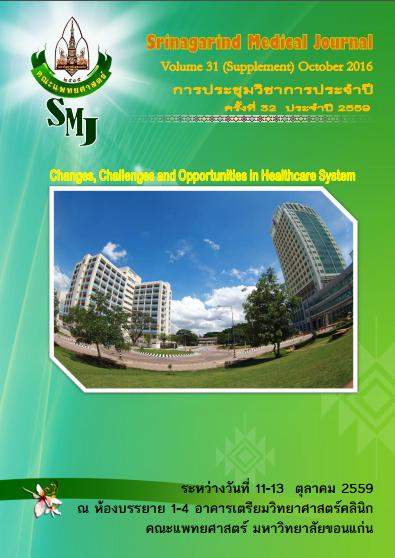Antihypertensive and Antioxidative Effects of Tubtim Chum Phae Rice Bran Hydrolysates in L-NAME-Induced Hypertensive Rats
Keywords:
Hypertension, Oxidative stress, L-NAME, Tubtim Chumphae rice bran hydrolysatesAbstract
Background and objective: Tubtim Chum Phae rice is rice from hybridization between Hom Mali rice and Sung Yod rice. It can be grown all year round and in all regions of Thailand. Tubtim Chum Phae rice (SRN06008DS-18-1-5-7-CPA-20) used in this study is grown in Chum Phae District, Khon Kaen Province. It is known that rice bran protein hydrolysates contain a number of nutrients and bioactive compounds, including dietary fiber and phytochemicals with potent antioxidant activities. Hypertension appears to have a complex association with endothelial dysfunction and oxidative stress. Therefore, this study aimed to investigate whether Tubtim Chum Phae rice bran hydrolysates (TCRH) could reduce blood pressure, endothelial dysfunction and oxidative stress in rats with Nω -nitro-L-arginine methyl ester (L-NAME)-induced hypertension.
Methods: Male Sprague-Dawley rats were induced hypertension by administering L-NAME (50 mg/kg/day) in their drinking water for 3 weeks, and TCRH at dose of 500 mg/kg/day was simultaneously intragastrically administered to animals. Rats received distilled water was served as normotensive controls. The blood pressure was monitored every week. The hemodynamic status, vascular responses to vasoactive agents and oxidative stress were evaluated at the end of the experimental period.
Results: L-NAME administration induced increased arterial blood pressure and elevated peripheral vascular resistance when compared with untreated controls (p<0.05). Vascular responses to acetylcholine and angiotensin II were altered in L-NAME hypertensive rats. TCRH significantly suppressed blood pressure elevation, decreased vascular resistance and restored vascular responsiveness (p<0.05). Moreover, the improvement of hemodynamics and endothelial dys function in L-NAME hypertensive rats was associated with a reduction in vascular superoxide production and plasma malondialdehyde level.
Conclusion: Overall results suggest that TCRH prevented the development of hypertension and endothelial dysfunction induced by L-NAME, and these effects might be involved with their antioxidant properties.




